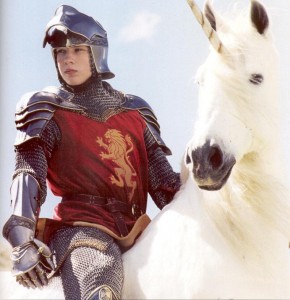Wesley Fryer attended a session titled “Prince Caspian” and the Return to Narnia: Making the Journey to Literacy Through Fantasy. It was a presentation done by Randy Testa, Vice President of Education for Walden Media, LLC. Randy shared this presentation at the 2007 EncycloMedia presentation in Oklahoma City on 8/29/2007.
There are 9 excerpts from “The Lion, the Witch and the Wardrobe” on the free DVD that was received, and an educator’s guide that goes with the DVD. The educator’s guide facilitates conversations with students about what happens in the movie, what happens in the book, etc.
Educator DVD has nice menu of 9 clips
1- Lucy Discovers the Wardrobe
2- Lucy & Mr Tumnus Intro
3- The White Witch Tempts Edmond
4- Mr and Mrs Beaver Explain the Prophesy
5- Father Christmas
6- The Children Ask Aslan for Help
7- Edmond is Forgiven
8- The Four Children are Crowned
9- Creating Creatures: Mr. Tumnus
We selected clips that really get at the guts of the story, not battle scenes
– there are extraordinary turning points in this story
– the narrator, CS Lewis, interrupts the story of Edmond’s forgiveness to say “never before and never since”
– ask students “What do you think Aslan said to Edmund?”
Walden Media did “Bridge to Terebithia,” “Charlotte’s Web,” “Because of Winn Dixie,” our sister company also did “Amazing Grace” about abolition of the slave trade
– We also did “Lion, Witch”
– some states have talked about requiring a curriculum where people learn about Wilbur Wilberforce
Have rich opportunities for comparative analysis between books and movies!
– Does there have to be an original text?
– Can there be a conversation between the texts?
Even more important
Coming from the point of view of a 3rd grade teacher: If you are going to, some kids need to experience a story in a variety of modalities; retention, comprehension, capacity for empathy (what Henry James called “the felt life”). It is an occasion to teach about media literacy and multiple forms of literacy.
A personal beef: Who, What, Where, When, and Why?
– WHO says children shouldn’t simultaneously be reading “on” “above” and “below” grade level?
– WHAT makes educators sabotage the very goals they extol? (e.g. “life-long readers”)?
– WHERE did the current obsession with “the grade level of this book” come from?
– Since WHEN is Charlotte’s Web “primarily for students in grades K-3?″
– WHY can’t AP ‘honors English’ students read “Prince Caspian?”
The “Annotated Charlotte’s Web” is a great work.
Educators always ask “what grade level is this book?”
– I wish had a lever
– since when is that the first question you ask about a book you don’t know??????
Reading Levels and Formulas Don’t Necessarily Create Lifelong Readers
Children who become lifelong readers:
– have access to books
– make THEIR OWN CHOICES about what to read
– are actively encouraged to read ‘above’ and ‘below’ ‘grade level’ (from “Formula for Failure” by Betty Carter, Associate Professor of Library Science, School of Library and information Studies, Texas Women’s University, Denton, TX)
Why teachers (generally) avoid using film
“Pop and play” is not teaching (popping in a movie and going down the hall
– opposite of kids seeing the movie is true: they see the movie, many want to read the book!
– perceived by school heads and/or parents as “babysitting” (i.e. not academic)
– “we can’t take the time in our school to show a movie”
Teachers don’t value film, as an art form, or in their own lives
– most teachers just see 4 movies per year
– this is in STARK contrast to the movie watching habits of our youth
– we need (as teachers) to watch more movies, be more literate of film as a genre and value it more
Librarians are the people in a school who know where the action is.
– AASL: we work with them a lot
Consider: Books and Films are both texts
– written text
– visual text
– same message: tell a story
– different symbol system
Big question: what do you mean by “faithful adaptation?”
– in your own off-stage life, consider “what is the difference between a LITERAL adaption and a FAITHFUL adaptation”
Lois Lowry’s definition: A faithful film adaptation is one that is “true to the spirit of the book”
Clive Staples Lewis
– brings us to The Chronicles of Narnia
Opening line “because of the air raids” was something everyone knew about and understood when the book was published just 5 years after WWII. There were posters all over the city that said sending your kids out of the city is your patriotic duty.
Juxtapose image of air raid opening scene from LWW and the twin towers.
Example of a five year old’s story about the twin towers.
– in some schools kids and teachers have been told, “we’re not going to talk about that [the twin towers attack and tragedy] because it is too scary”
– what we know is that, from Vivian Paley: “…the children must be able to imagine themselves swimming to safety and using their jackets as pillows…”
Another great piece of ammo: CS Lewis’ essay “On Three Ways of Writing for Children” from “On Stories and Other Essays On Literature”
– fantasy is vital because it helps children make sense of reality in a way that “school stories” do not and cannot
Making sense of reality
– twin towers
– through fantasy
– first grade art examples
At play, kids explore reality, morality, fantasy…
Lewis was well aware of the arguments.
Opening line of Charlotte’s Web: “Where is papa going with that ax?”
Lewis’ question: are we making the destinies of children BRIGHTER or DARKER?
So here we are, in Narnia on the screen
– Lewis felt that for a fantasy to work, it had to be grounded in the realities of the present day
– at the end of the film, the phoenix’s come into the battle scene and come in in the same formation as the German bomber planes at the start of the film.
From the creative brief for Disney/Walden for thinking about Prince Caspian
– a parallel universe that expands through time
– vast, multi-layered world
With Narnia time, things are really messed up. Powerful theme of Caspian blowing the horn. When you hear the call, will you be ready?
Walden Media will be holding a contest for kids and educators: Who is your Dr. Cornelius?
Aslan: “Things never happen in the same way twice”
That was then, this is now…
– more than 1300 years have passed, Miraz is in power.
Story of Prince Caspian: “is about reawakening lost faith in a new Narnia barely recognizable from its former self”
King Mirax is a real bad guy, a real bad villain.
– all three paths collide: children, Prince Caspian, and Narnia in a new era.
LA partners talk about the Narnia series as a “franchise”
– in Prince Caspian you will meet characters who you’ll see later in the series
Our new hero: Prince Caspian
– educated
– knowledge: “he learned the difference between wisdom and knowledge”
– Lewis hated what was going on in the schools at the time in England
Dr Cornelius: half dwarf, half Telmarine
– what does it mean to be devoted to one’s students?
– not just efficient or concerned, but DEVOTED?
Nikabrik: a black dwarf soured by hate
Trufflehunter: Prince Caspian’s most loyal servant
Trumpkin: good hearted dwarf
Reepicheep: (my favorite)
– there are 12 of them: not 6, not 4
– when Reepicheep has his tail cut off, his brothers are all going to cut off their tales so he is not shamed
– that is my favorite scene in the book
Same four kids in the movie
– they are a year older, voices are breaking
Great lion to Lucy: “You are a lioness!”
Aslan: again the voice of Liam Neesan.
Library of Congress doing a massive literacy camapign
– also “Read It Before You See It” campaign from Harper Collins
lots more on narnia.com
www.walden.com
– downloadable educator guides
– PD presentations and materials, like CS Lewis and the Moral Imagination
– Online discussions for teachers and librarians only
– previews of coming attractions
Walden IS doing all 7 movies
– we are Walden.com not Walden.org
– slogan is “Recapturing imagination, rekindling curiosity”
Drawn Treader has just been green lit and filming is about to start
– Director of “Amazing Grace” is going to direct it, Andrew Adamsen couldn’t do it because of timing
Also releasing “The Water Horse” this December.
For more notes and information, check out the full notes on “Moving at the Speed of Creativity“


